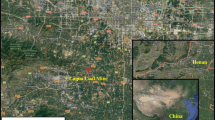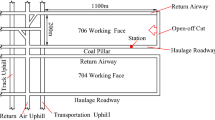Abstract
Extraction of a 10-m-thick coal seam in one single lift using the longwall top coal caving method caused severe deformations in underground roadways in Majialiang coal mine in Shanxi Province, China. Field monitoring of stress changes in the roof and in the coal pillar, and deformation of the 14202 tailgate, were carried out. The deformation monitoring found that the maximum floor heave of the 14202 tailgate was 1.85 m when the monitoring point was 250 m behind the longwall working face, while the maximum roof subsidence and the maximum rib–rib convergence was 0.93 and 1.14 m, respectively. The deformation rate of the 14202 tailgate increased dramatically when the monitoring point was at distances of 100–150 m behind the longwall working face, which reflected the fact that the tailgate underwent sharply increased loads within this range. Field monitoring of stress changes and the displacement of the 14202 tailgate revealed that the impact range of the mining-induced stresses in longitudinal direction (the same as the mining direction) was from 60 m ahead of the longwall face to 250 m behind the longwall face. Additionally, the mining impact range in transverse direction was more than 45 m, indicating that the coal pillar width should be larger than 45 m to avoid significant influences of mining-induced stresses. This finding was applied to the 14103 tailgate, which was subjected to similar mining and geological conditions as the 14202 tailgate. A coal pillar with width of 56 m was adopted in the 14103 tailgate, and displacement monitoring showed that large deformation was successfully controlled. The field investigations in this study provide a basis for design of a proper coal pillar width of underground roadways when subjected to large stresses induced by mining of thick coal seams in a single lift.














Similar content being viewed by others
References
Alehossein H, Poulsen BA (2010) Stress analysis of longwall top coal caving. Int J Rock Mech Min Sci 47:30–41. doi:10.1016/j.ijrmms.2009.07.004
Huang B, Wang Y, Cao S (2015) Cavability control by hydraulic fracturing for top coal caving in hard thick coal seams. Int J Rock Mech Min Sci 74:45–57. doi:10.1016/j.ijrmms.2014.10.011
Ju J, Xu J (2013) Structural characteristics of key strata and strata behaviour of a fully mechanized longwall face with 7.0 m height chocks. Int J Rock Mech Min Sci 58:46–54. doi:10.1016/j.ijrmms.2012.09.006
Kumar R, Singh AK, Mishra AK, Singh R (2015) Underground mining of thick coal seams. Int J Mining Sci Technol 25:885–896. doi:10.1016/j.ijmst.2015.09.003
Li W, Bai J, Peng S, Wang X, Xu Y (2015) Numerical modeling for yield pillar design: a case study. Rock Mech Rock Eng 48:305–318. doi:10.1007/s00603-013-0539-8
Mandal PK, Singh R, Maiti J, Singh AK, Kumar R, Sinha A (2008) Underpinning-based simultaneous extraction of contiguous sections of a thick coal seam under weak and laminated parting. Int J Rock Mech Min Sci 45:11–28. doi:10.1016/j.ijrmms.2007.03.005
Qian MG, Miao XX, Xu JL, Mao XB (2003) Study of key strata theory in ground control. China University of Mining and Technology Press, Xuzhou
Shen B (2014) Coal mine roadway stability in soft rock: a case study. Rock Mech Rock Eng 47:2225–2238. doi:10.1007/s00603-013-0528-y
Singh R (2004) Staggered development of a thick coal seam for full height working in a single lift by the blasting gallery method. Int J Rock Mech Min Sci 41:745–759. doi:10.1016/j.ijrmms.2004.01.008
Singh AK (2010) Studies on mining induced vertical stress ahead of a depillaring face in Indian geo-mining conditions. Bengal Engineering and Science University, Sibpur
Singh R, Mandal PK, Singh AK, Singh TN (2001) Cable-bolting-based semi-mechanised depillaring of a thick coal seam. Int J Rock Mech Min Sci 38:245–257. doi:10.1016/S1365-1609(00)00075-7
Singh R, Mandal PK, Singh AK, Kumar R, Maiti J, Ghosh AK (2008) Upshot of strata movement during underground mining of a thick coal seam below hilly terrain. Int J Rock Mech Min Sci 45:29–46. doi:10.1016/j.ijrmms.2007.03.006
Singh R, Mandal PK, Singh AK, Kumar R, Sinha A (2011a) Coal pillar extraction at deep cover: with special reference to Indian coalfields. Int J Coal Geol 86:276–288. doi:10.1016/j.coal.2011.03.003
Singh R, Singh AK, Maiti J, Mandal PK, Singh R, Kumar R (2011b) An observational approach for assessment of dynamic loading during underground coal pillar extraction. Int J Rock Mech Min Sci 48:794–804. doi:10.1016/j.ijrmms.2011.04.003
Unver B, Yasitli NE (2006) Modelling of strata movement with a special reference to caving mechanism in thick seam coal mining. Int J Coal Geol 66:227–252. doi:10.1016/j.coal.2005.05.008
Yan H, He F, Yang T, Li L, Zhang S, Zhang J (2016) The mechanism of bedding separation in roof strata overlying a roadway within a thick coal seam: a case study from the Pingshuo Coalfield, China. Eng Fail Anal 62:75–92. doi:10.1016/j.engfailanal.2015.12.006
Yu B (2016) Behaviors of overlying strata in extra-thick coal seams using top-coal caving method. J Rock Mech Geotech Eng 8:238–247. doi:10.1016/j.jrmge.2015.11.006
Yu B, Zhang Z, Kuang T, Liu J (2016) Stress changes and deformation monitoring of longwall coal pillars located in weak ground. Rock Mech Rock Eng 49:3293–3305. doi:10.1007/s00603-016-0970-8
Zhang G, He F, Jia H, Lai Y (2017) Analysis of gateroad stability in relation to yield pillar size: a case study. Rock Mech Rock Eng. doi:10.1007/s00603-016-1155-1
Acknowledgements
The authors acknowledge financial support from the National Natural Science Foundation of China through contract no. 51504246, the State Key Laboratory of Coal Resources and Sate Mining, CUMT (SKLCRSM13X07). The support of Majialiang coal mine during field investigation is acknowledged.
Author information
Authors and Affiliations
Corresponding author
Rights and permissions
About this article
Cite this article
Chen, Y., Ma, S. & Yu, Y. Stability Control of Underground Roadways Subjected to Stresses Caused by Extraction of a 10-m-Thick Coal Seam: A Case Study. Rock Mech Rock Eng 50, 2511–2520 (2017). https://doi.org/10.1007/s00603-017-1217-z
Received:
Accepted:
Published:
Issue Date:
DOI: https://doi.org/10.1007/s00603-017-1217-z




